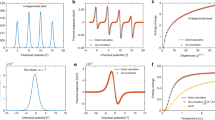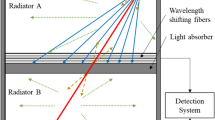Abstract
IN a communication in NATURE1 it was concluded that the heavy ionization tracks found in Ilford New Halftone plates kept exposed to cosmic rays at Sandakphu (12,000 ft.) were chiefly due to mesotrons. The basis of this conclusion was a comparison of the mean grain spacing and curvature of tracks due to cosmic rays with tracks due to protons of known energies on similar plates.
This is a preview of subscription content, access via your institution
Access options
Subscribe to this journal
Receive 51 print issues and online access
$199.00 per year
only $3.90 per issue
Buy this article
- Purchase on Springer Link
- Instant access to full article PDF
Prices may be subject to local taxes which are calculated during checkout
Similar content being viewed by others
References
NATURE, 147, 240 (1941).
Williams, E. J., Proc. Ray. Soc., A., 169, 539 (1939).
Wambacher, Phys. Z., 39, 888 (1939).
Dunning, Phys. Rev., 45, 586 (1934); Bonner, Mott and Smith, Phys. Rev., 46, 258 (1934).
Blau, J. Phys. et Rad., 61 (1934).
Bethe, Phys. Sev., 57, 260 (1940) estimates that the most reliable measured values of µ lie between 150 and 220 m0. When certain corrections are made, it is expected that the former will be increased by at least 10 percent.
Author information
Authors and Affiliations
Rights and permissions
About this article
Cite this article
BOSE, D., CHOUDHURI, B. A PHOTOGRAPHIC METHOD OF ESTIMATING THE MASS OF THE MESOTRON. Nature 148, 259–260 (1941). https://doi.org/10.1038/148259a0
Issue Date:
DOI: https://doi.org/10.1038/148259a0
This article is cited by
-
Bibha Chowdhuri and Her Remarkable Scientific Endeavours
Resonance (2024)
-
Die photographische Emulsion in der Kernphysik
Die Naturwissenschaften (1948)
-
PROCESSES INVOLVING CHARGED MESONS
Nature (1947)
-
A Photographic Method of Estimating the Mass of the Mesotron
Nature (1942)
Comments
By submitting a comment you agree to abide by our Terms and Community Guidelines. If you find something abusive or that does not comply with our terms or guidelines please flag it as inappropriate.



